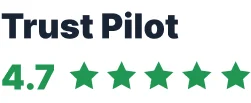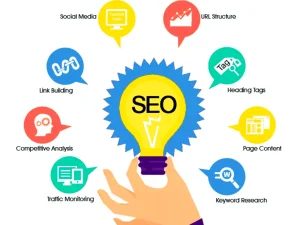A well-crafted website is indispensable for any business in 2024. With over 5.19 billion internet users, establishing a robust online presence can distinguish your business from the competition. A comprehensive Web Design Checklist is crucial in creating a site that captivates and retains visitors. This blog offers an extensive guide to web design, ensuring your success. You will discover what constitutes an effective website and how to implement these strategies proficiently. Google favours sites that adhere to a structured approach, and this checklist will assist you in achieving exemplary website design. Delve into the significance of Website Maintenance, eCommerce Maintenance, and WordPress Maintenance for sustained success.
What Are Your Website Goals?

How to Define Your Website’s Purpose?
Identifying the goal of your website is one of the most important things you need to consider in web design. It is for this reason that there is a clear purpose that is used as a reference in the design process. First of all, define who your audience is. Knowing who is likely to come to your site enables one to design features and information to suit the users’ expectations. It is possible to take into account such characteristics as age, interests, and behaviour on the Internet.
Another critical area is the management of objectives that are set in the organization. The goals give specific goals to work towards and help to keep one on track. The first step in creating the content is to determine if the website is going to be informative, persuasive or recreational. Every goal is addressed by different design strategies. For instance, an e-commerce site has to ensure that the site is easy to navigate and that there are secure ways of paying for a product. A blog is more concerned with the content and the level of interaction that is created between the users.
Expert Testimony:
“Setting realistic goals for your website is more likely to succeed which you can continue to build upon.” Andrew Lowry, Website Goals Expert
What Makes Goal Setting Important for Web Design?
This is because goal setting helps to ensure that your design is in line with the business goals. A website has to be a representation of your brand’s goals and beliefs. This is because the colours and fonts that are used to develop the brand should be consistent throughout the brand. This consistency is beneficial in maintaining the user experience and also improving the trust of the users on the website.
Measuring success through Key Performance Indicators (KPIs) is vital. KPIs track progress towards your goals. Common KPIs include page views, conversion rates, and bounce rates. Regularly reviewing these metrics helps identify areas for improvement.
Expert Testimony:
“Remember: When creating SMART website goals, keep them actionable. Because making your website more accessible isn’t as easily measured with data, you’ll have to get creative when setting your SMART goal.” HubSpot, Website Goals Expert
Which Platform Should You Choose for Creating a Good Website?

How to Select the Right Website Builder?
Selecting the right website builder is crucial for your web design journey. Popular platforms like WordPress, SQUARESPACE, and SHOPIFY excel in e-commerce capabilities. Each platform caters to different needs. WordPress provides flexibility with numerous plugins. SQUARESPACE offers simplicity with all-in-one features. SHOPIFY excels in e-commerce capabilities.
SQUARESPACE suits beginners and small businesses. The platform’s simplicity makes it easy to use. SQUARESPACE includes hosting, eliminating the need for separate arrangements. SHOPIFY focuses on building e-commerce websites. The platform supports product sales effectively. WordPress offers extensive customisation options. However, the platform can overwhelm with choices.
How to Select the Right Website Builder? compare WordPress & Square Space
Selecting the right website builder depends on your needs, budget, technical skills, and long-term goals. Here’s a comparison of WordPress and Squarespace to help you choose the right platform:
1. Ease of Use
- WordPress: WordPress is more flexible than the first one, but the second one is comparatively difficult for those who are new to the programming field. Some basic knowledge of hosting, themes and plugins is needed.
- Squarespace: It is straightforward to use and has a user interface where one has to drag objects onto the screen. Perfect for beginners or those who don’t have time or desire to learn coding.
2. Customization
- WordPress: Very flexible with many thousands of templates and extensions. Developers can make changes to the code for full control over the design and the functionality of the website.
- Squarespace: Fewer choices for customization than WordPress. There is nothing wrong with templates, but they can’t be as fine-tuned unless you use custom CSS.
3. SEO Features
- WordPress: Great for SEO since there are plugins such as Yoast SEO that come with advanced settings to work with. Complete freedom to manage all the technical aspects of SEO.
- Squarespace: Has integrated SEO options that are pretty simple but more convenient than WordPress ones. It is ideal for small to medium websites that do not require complicated SEO solutions.
4. E-Commerce Capabilities
- WordPress: Can integrate with WooCommerce for highly effective and efficient e-commerce platforms. It is highly scalable but is more complex to set up and manage than the previous option.
- Squarespace: Integrated shopping carts, perfect for small businesses and shops. Easier to install as compared to the other two types, but not as effective for big or complicated stores.
5. Cost
WordPress: Available for free, but you will have to incur other costs such as hosting, premium themes, plugins and security. The costs can be high or low depending on the requirements of the project.
Squarespace: Offers hosting plans with fixed prices and has templates and e-commerce options as well. Pricing is straightforward, but it can be more costly for the long-term vision of the firm.
6. Support
- WordPress: Dependent on the community boards, third-party guides, and plugins for assistance. There is no support team unless you hire a developer or use managed hosting.
- Squarespace: It provides customer support for the users through email and live chat at any time of the day. Perfect for users that require assistance and do not want to go through the technicalities involved.
7. Flexibility and Growth
- WordPress: Very flexible, which means that it can be used for all types of websites, big and small. Ideal for companies that have the ambition to develop and enhance the use of the website.
- Squarespace: More suitable for less complex websites or businesses that do not need a lot of customization or growth. A small amount of flexibility as your site expands.
Ease of use and features should be considered and assessed. SQUARESPACE is easy to use. The platform helps to reduce the number of steps that need to be taken in the design process. SHOPIFY can be integrated with different modes of payment. It also guarantees safe transactions through the platform. WordPress is endowed with a rich repository of themes and plugins. It also enables one to make a lot of customization since it is an online platform.
Expert Insight:
“The term Squarespace website often refers to a site that prioritises design and functionality. A Squarespace website designer can create visually appealing sites with ease.” Squarespace SEO Expert Henry
Squarespace SEO is another consideration. The Ultimate Squarespace SEO Checklist helps optimise your site. Squarespace SEO enhances visibility in search engine results. Squarespace SEO involves optimising images and meta descriptions. Squarespace SEO ensures your site ranks well.
Complete Squarespace Tutorial guides you through the process. The tutorial covers design and SEO aspects. Squarespace website designer expertise enhances your site’s appeal. A Squarespace website designer ensures cohesive branding. A Squarespace website designer focuses on user experience.
How to Plan Your Website Structure? Essential web design checklist.

What is a Sitemap and Why is it Important?
A sitemap serves as the blueprint for your site. Creating a logical flow ensures that users can navigate your pages effortlessly. A well-organised sitemap guides visitors through your site, enhancing their experience. The structure of your site should reflect the priorities of your business.
- Creating a logical flow involves arranging your pages in a way that makes sense to users. Group related pages together to create a seamless journey. For example, an e-commerce site might organise product categories under a main shopping page. This approach simplifies navigation and improves user satisfaction.
- Ensuring user-friendly navigation is crucial for retaining visitors. A clear and intuitive menu helps users find information quickly. Studies show that improved navigation reduces bounce rates and increases conversions. The Website Redesign Case Study – Magento CMS Shift demonstrated this by reducing bounce rates and speeding up information retrieval.
How to Organise Your Content Effectively?
Organising content effectively is key to engaging your audience. Prioritising key information ensures that visitors find what they need without hassle. Place the most important content at the top of your pages. This strategy captures attention and encourages further exploration.
Prioritising key information involves highlighting essential details. Use headings and subheadings to break up text and guide readers. Bullet points and numbered lists make information digestible. An e-commerce concept redesign case study showed how enhancing architecture led to an innovative browsing experience.
Using categories and tags helps organise content logically. Categories group similar content, making it easier to locate. Tags provide additional context and improve searchability. Implementing these elements enhances user engagement and boosts SEO performance. The integration of a chat feature in a case study improved website architecture and user interaction.
A comprehensive website checklist aids in structuring your site effectively. This checklist covers all aspects of planning, from sitemaps to content organisation. Following a structured approach ensures that your site meets user needs and business goals.
What is the best web design checklist for designing an engaging website?

The web design process in 2024 embraces simplicity and interaction. Minimalist design leads the way. This approach removes clutter and focuses on essential elements. Users find navigation easier on clean websites. A study from Crucible.io highlights that users prefer structured designs. Overcrowded sites discourage user actions. Minimalism enhances user experience by providing clarity.
The interactive design captures attention and encourages exploration. Websites with interactive elements often see increased engagement. Users spend more time exploring these sites. The web design process benefits from incorporating such trends.
How to Ensure Your Design is User-Friendly?
Responsive design principles ensure accessibility across devices. The web design process must consider desktops, mobiles, and tablets. A study from Coursera.org emphasises thumb-friendly mobile design. Users navigate easily with optimised layouts. Responsive design adapts to various screen sizes. This flexibility enhances user experience significantly.
Accessibility considerations play a crucial role. Websites should cater to all users, including those with disabilities. The web design process involves implementing features like alt text for images. Screen readers rely on this text to describe visuals. Colour contrast and font size adjustments improve readability. Accessible design ensures inclusivity for all visitors.
Scientific Research Findings:
- Function and Usability Key for User Experience: Functionality outweighs visual appeal in user experience. Users prioritise ease of use over aesthetics.
- Optimising Website Speed for User Experience: Fast-loading sites retain users better. Speed optimisation boosts engagement and search rankings.
The web design process in 2024 focuses on user-centric approaches. Minimalism, interactivity, responsiveness, and accessibility define successful websites. Implementing these strategies enhances user satisfaction and site performance.
How to Create Compelling Content?

What Types of Content Should You Include?
To design a good website from the scratch, one has to ensure that the website contains a diversity of content. Texting, images, and videos are the rudimentary of any interesting site. Text offers description and background information. Pictures are eye-openers and are capable of passing messages across in the shortest time possible. Videos make users interact with content through the use of moving pictures.
User-generated content adds authenticity. Make sure that the visitors are encouraged to post their reviews or testimonials. Such interaction creates trust and community or even a sense of belonging to a particular group. There is also the fact that user-generated content helps in engagement, which is another factor that helps in SEO.
Tools can enhance your content significantly. Content at Scale AI Writer helps produce original articles. This tool ensures your content remains unique and research-backed. Semrush offers insights into competitors’ strategies. Use this tool to find top-performing keywords and backlinks. Keyword Magic by Semrush identifies search terms to include on your website. These tools streamline content management and improve visibility.
How to Write for the Web?
- There are certain approaches that need to be followed while writing for the web. The use of headlines and subheadings attracts the readers to the content. When writing your titles, make sure to use powerful words. Headings should be in the form of questions so as to create curiosity among the readers.
- SEO best practices help optimise the content for search engines. It is necessary to pay attention to the fact that the text should be as clear and concise as possible. It is also recommended to use short sentences and short paragraphs so that the text can be easily read. Ensure that the content is Search Engine Optimised by naturally including the right keywords.
- Post relevant content which you have gathered from your experience. Post such information that would be of value to your audience. Tips are useful and add to the site’s reliability, which leads to repeat visitors. Efforts such as these are supported by a well-crafted content management system. This system helps to arrange your content and then store it in a proper way.
- To create a DIY website, these principles have to be understood. There are free web design checklists that help in the process. They help make sure that you do not miss out on any area of content development. This is because a structured approach is followed in the process of launching the product.
How to Optimise Your Website for SEO?

What Are the Key SEO Strategies for 2024?
It is clear that Search Engine Optimisation (SEO) is still important in 2024. Strategies that are effective help to make an entity or product noticeable and interesting. Keyword research is the first step and the basis. Find out keywords that your target group employs. Use these keywords in your content flow naturally. This approach helps to increase the relevancy of your site.
- There is always a great focus on both on-page and off-page optimization. On-page SEO entails the optimisation of factors such as the title and meta description. Off-page is more on the quality of the link that is being created. Both strategies increase the authority of your site. It also means that a good backlink profile helps to improve your search rankings.
- Focus on E-E-A-T: The four pillars of credibility are Experience, Expertise, Authoritativeness, and Trustworthiness. The following factors are the key determinants of Google’s ranking. The quality of the content is one of the ways through which one can show that he or she is an expert in a certain field. Gain the trust of the audience by offering real information. This results in better visibility of the authoritative sites.
- Search Intent Optimisation helps in matching the content with the user’s requirements. It is important to know what users want when they search. Adapt the content to these needs. It also enhances user satisfaction and the level of their activity.
- It is also worth mentioning that Core Web Vitals and Page Experience are among the ranking factors. It should also load quickly and be easily viewable on mobile devices. User-friendly is appealing to the site as it improves its flow. Google prefers sites that offer great page experiences.
- Video Content SEO becomes relevant. Ensure that the videos are optimised with the right keywords. Choose a descriptive title and captions. Videos keep users active and also allow them to spend more time on your site.
- There are two new trends which are Visual SEO and Voice Search SEO. Optimise images with the use of alt text and appropriate filenames. This means that voice search needs conversational keywords. In order to increase reach, modify your content into these formats.
- Local SEO and “Near Me” Searches are focused on local customers. Ensure that you use local keywords in your site. Make sure that all the business information you are putting out there is correct. Local searches help to target the traffic to your site.
- Local SEO and “Near Me” Searches target local audiences. Optimise your site for local keywords. Ensure your business information is accurate. Local searches drive targeted traffic to your site.
How to Monitor and Improve Your SEO Performance?
- The fact is that constant checking of SEO results guarantees its further effectiveness. There are other tools that can be used such as Google Search Console. Other metrics that should be tracked include impressions and clicks. These insights unveil your site’s performance.
- Always ensure you change your content as often as possible to ensure that it is up to date. Updating the content of the site attracts the search engines and the users. Revise old information and include new knowledge.
- Use Google Analytics to monitor the most important parameters. Keep track of the bounce rates and the conversion rates. These metrics define the activity level of the users.
- Perform SEO audits on a frequent basis using tools. Find out the strengths and weaknesses of the current processes.
- Audits help to keep your site competitive. Track the keyword rankings and the overall performance trends.
- Monitor shifts in the position of the site in the search results. This means that one should shift his or her strategy depending on these trends.
- Check backlinks and ensure that one has a good link reputation. Good backlinks improve your website’s credibility. Avoiding links that are damaging to your reputation is one of the best ways of protecting your online reputation.
Survey Results:
- SEO Trends of 2024 highlight E-E-A-T and Core Web Vitals as key ranking factors.
- Respondents include SEO and marketing professionals.
- E-E-A-T and Core Web Vitals shape SEO strategies.
How do you launch and maintain your website? Usefull website checklist.

What Steps to Take Before Launching?
- Launching a website requires thorough preparation. Testing for bugs and errors ensures a smooth user experience. Use automated testing tools to examine performance and functionality. Fix any issues before going live.
- Security measures protect your site from threats. Implement SSL certificates and strong passwords. Regularly update security protocols to safeguard data.
- Connecting to Google Console is essential. This tool provides insights into search performance and indexing status. Monitor your site’s health with Google Console.
- Request Google Analytics integration. This tool tracks visitor behaviour and engagement. Analyse data to improve user experience.
- Ensure a full website backup before launching. A backup protects against data loss. Request a copy from your Hosting Provider.
How to Keep Your Website Updated?
Regular content updates keep your site fresh. New articles and images engage visitors. Update your blog frequently to maintain interest.
Monitor website performance with analytics tools. Track metrics like page load times and bounce rates. Use this data to enhance user experience.
Write regular content for your blog. Optimise articles with relevant keywords. Engaging content attracts and retains visitors.
Website maintenance packages should cover several areas:
- Theme and Plugin Updates: Regular updates keep your site stable. Outdated themes can cause compatibility issues.
- WordPress Updates: Scheduled updates ensure security. Regular updates prevent bugs and vulnerabilities.
- Swift Fixes: Fix problems resulting from updates as soon as possible. Temporary solutions are used to sustain the operation of the site.
- Regular Cloud Backup: Backup your content and CODE so that the loss of one or the other does not lead to a complete disaster. This is because regular backups are very essential in avoiding loss of data.
- Website Restore Services: Make sure that restoration is done within 24 hours. Quick recovery minimises downtime.
- Up and Down Monitoring: Check on-site accessibility. Save your SEO ranking with timely alerts of loss.
- SSL Monitoring: Scanning is done on a regular basis to ensure that your site is secure. SSL certificates help to secure users’ information.
- Sucuri Scanning: Security patching helps in avoiding attacks. Regular scans identify vulnerabilities.
- Speed Monitoring: The fast sites enhance the user experience. Minimise the bounce rates by ensuring that the loading time of the website is as short as possible.
- Spam and Comments Removal: Delete hazardous links. Protect content from spam.
- Domain Monitoring: Maintain your website active. Monitor domain status regularly.
- iTheme Security Scanning: Secure your site with a check-up. Security scans detect threats.
- Google Console Maintenance: Crucial during PPC and SEO advertising and marketing procedures. Evaluation and control of performance.
- Collaborating with Marketing Companies: Promote on the web. Engage the right experts for your growth.
- Monthly Google Analytics Reports: The other key activities in the management of the change process include tracking progress and performance. Reports are essential, and frequent reports are very useful.
- Scheduled Website Update Reports: Be aware of the changes. They keep you updated, which gives you control of the situation.
- Hosting Updates: Saves time through the frequency of updates. Make sure that your Hosting stays optimised.
- Custom Tracing Codes: Get more tracking as an added advantage. Custom codes offer specific information.
- Scheduled WooCommerce Reports: Supervise the e-commerce metrics. Reports are generated and prepared to monitor sales and any pattern that may be identified.
Paige Brunton, an expert in website design, emphasises the importance of a comprehensive maintenance Checklist. Regular updates and monitoring ensure your site remains competitive. Paige advises using tools like Hostinger for reliable Hosting solutions. Hostinger offers robust features that support site stability.
A well-maintained website enhances user experience. Regular updates and monitoring keep your site relevant. Follow these steps to ensure success.
A well-structured Web Design Checklist ensures a smooth and efficient Website Design process. Following this checklist helps you create a site that stands out in 2024. Start building your website today with platforms like SQUARESPACE or WordPress. Stay updated with the latest trends to keep your site engaging and relevant. Regular Website Maintenance, including SEO and eCommerce Maintenance, is crucial. Keep your site fresh with ongoing updates and WordPress Maintenance. A successful website boosts your business and enhances your online presence.
Extra top 10 Frequently SEO & Web Design Questions our Clients ask for Guidance during Discovery Calls.
How do I make my web content clear and simple?
To make your content easy to understand, avoid long sentences and blocks of text. Do not use technical terms and complicated phrases. Use active voice, and do not beat around the bush. Make ideas short and simple, so that the readers can just skim through the content. They should not exceed 2-3 sentences, and the text should be written in simple language.
Why are headlines and subheadings important in web writing?
For SEO, ensure that you find and incorporate the right keywords in your titles, headings and body text. Create a meta description that informs the reader about the content of the page and persuades them to click. Make use of keywords in the URLs and title tags, and always use alt tags on images. Do not use keyword stuffing because it can harm the readability of your content, and the overall user experience as well as the SEO standards.
How should I format web content for better readability?
Bullet points, numbered lists, and short paragraphs should be used to make the content easier to consume. Use the headings or subheadings to make the important points stand out by making them bold or italic. Divide long sections of text with subtopics and use images, illustrations or even graphic images to make it easier to understand. Appropriate formatting helps the users remain interested in the content by making it possible to easily scan through it.
What is the role of user intent in writing for the web?
User intent means what the reader wants when they are turning to your page. To achieve this intent, make your content specific and give precise guidance or recommendations. Concentrate on presenting a solution to a problem, an answer to a query, or a prompt to the users on the next step to take. The content that is more relevant to the user’s needs is more interesting and persuasive.
How do I write effective meta descriptions?
Meta description should be brief and should not exceed 150-160 characters, it should be a description of the content. It should contain a relevant keyword and should be written in an engaging manner so that the users click on it. It can be considered as a small advertisement of the page, which describes what the reader will get if he or she visits the page.
Why is user engagement important in web content?
User engagement indicators to the search engines that your content is of high value and is useful to the users. Engagement is normally associated with low bounce rates, high time spent on the site and high conversion rates. To increase the audience engagement, your content should be visually appealing and easy to read with the use of images, lists and clear instructions on what the reader should do next.
How can I improve my website’s readability?
Enhancing the text’s readability means dividing the text into small sections that are easily understandable. Subheadings, short paragraphs, bullets, and lists should be used in the text. Do not use complicated language and jargon when writing the report. To achieve readability, you can use Hemingway or Grammarly so that your text can be understood by as many people as possible.
How do I incorporate visuals into web content?
Select pictures, graphics or videos that should be used in conjunction with the text and to attract users’ attention. It is also important to include visuals in the content because they provide the readers with breaks and remind them of the main ideas. Whenever images are used, make sure to use alt tags that are SEO-friendly. Make sure the images are of good quality and not very large to prevent the page from slowing down.
What are calls to action (CTAs), and how do I use them?
A CTA is a call to action which directs the readers to perform an action like subscribing for a newsletter, downloading a guide or purchasing a product. CTAs should be used correctly, simply, and placed at appropriate positions within your content. Utilize call-to-action phrases (for example, ‘Get Started’, ‘Learn More’) and make sure that the CTA corresponds to the user’s goal for the best performance.




























































































































